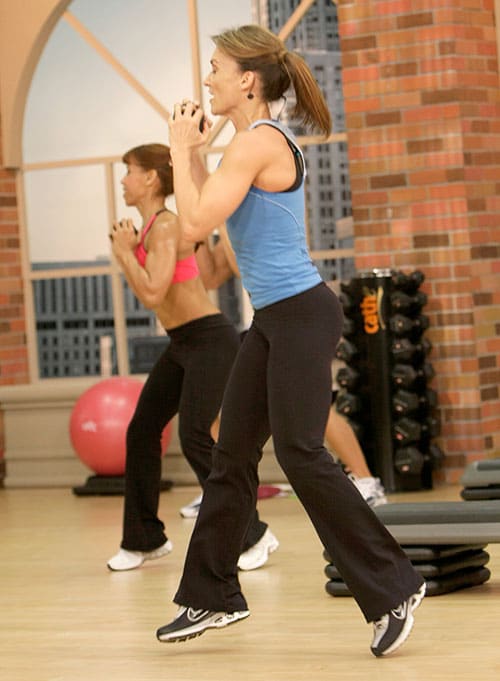
If you have limited time to train, you need to pack the most benefits into the time you have. You’ll hear people say there are no shortcuts to fitness. This is true to some degree. After all, you have to put in the time. Still, there are ways to get more benefits out of the time you have available. Here are some workout tips for doing that.
Take Advantage of Post Activation Potentiation
Post-activation potentiation is also known as “contrast training.” It’s a way to “trick” your brain and muscles into producing more force. Post-activation potentiation, or PAP, involves performing a heavy strength training move followed by an explosive or plyometric move that uses the same muscles just like we did in my STS Phase 3 leg workouts. For example, heavy squats followed by squat jumps. When you perform a heavy resistance exercise using the same muscle groups followed by an explosive or ballistic move, you maximize the amount of force you can generate during the ballistic move.
Why does this happen? When you lift heavy, your nervous system has to recruit a large number of motor units. These motor units, in turn, activate muscle fibers so you can lift the heavy load against resistance. During the heavy lifting exercise, you maximally stimulate your nervous system, but even after lifting that heavy load your nervous system is still “engaged.” As a result, when you do the explosive exercise that follows with more power.
How does this maximize your training? With PAP you’re building strength with the heavy resistance exercise AND power with the explosive move that follows. The strength-training move makes you stronger while the explosive element will improve your overall athletic performance. In addition, combining the two adds an additional fat-burning component to your workout by creating more metabolic stress. You’re building strength and power simultaneously.
Tabata Training
Tabata intervals are the ultimate way to maximize the time you spend training, especially if you have a short attention span. Tabata training, as you will find in my Tabatacise video, alternates short periods (20 seconds) of near-maximal intensity exercise with very short rest periods. (10 seconds) One Tabata round consists of eight 20 second active intervals separated by 10 seconds of rest for a total of 4 minutes. Most people start with one Tabata round and gradually work up to three or four complete 4-minute rounds with a minute rest in between. Even if you do three rounds with a warm-up and cool down you’ve invested less than 20 minutes of time.
How effective are Tabatas? Research shows Tabata training boosts aerobic AND anaerobic fitness. In fact, the original research on Tabatas showed they’re more effective than moderate intensity cardio for improving aerobic capacity. Plus, they boost anaerobic fitness as well. With Tabata and interval training in general, you can work out at a high intensity and accomplish more in less time. That’s a pretty sweet deal, don’t you think?
Circuit Training
With circuit training, you can get a total body workout in as little as twenty minutes. Your goal is to move quickly from resistance exercise to exercise with little or no rest between sets. Because you’re not pausing between sets, you keeping your heart rate up AND building muscle strength or muscular endurance, depending upon the amount of resistance you’re using. To maximize the cardiovascular benefits, do cardio circuits in between each resistance exercise. Circuit training is a way to effective way to “multitask” your workout. It’s a real timesaver.
Focus on Compound Movements
To get the most benefits from a resistance training session, devote more time to compound exercises. Compound exercises work more than one muscle group at the same time. Examples include squats, lunges, deadlifts, rows, bench press, and dips. Isolation exercises like biceps curls and triceps extensions work only a single muscle group.
When you have limited time, you can double the number of muscle groups you train by focusing mainly on compound exercises. As a general rule, do at least two compound exercises for every one isolation one. You can also turn isolation exercises into compound ones. Instead of doing biceps curls in isolation, combine biceps curls with squats or overhead presses with squats. You’re working more muscle groups and incorporating larger muscle groups at the same time.
Focus, Focus, Focus
When you work out, tune out all distractions. Turn off your cell phone. If you’re working out using a DVD, focus on the instructor and on using proper form. When you focus on each movement with laser-like precision, your form will improve and you’ll get greater benefits. Feel the muscle moving and embrace the burn. Visualize your goal. See the muscle getting bigger in your mind. Your mind is a powerful force for change. Use it to your advantage. Doing a lower number of reps with excellent form will give you more benefits than doing twice as many sloppy ones where you’re using momentum. Focus, visualize and succeed!
The Bottom Line?
Want to get more done in less time? Maximize the time you spend working out and the results you get with these techniques. Just as importantly, stay focused and free of distractions. Make every minute you work out count!
References:
Med Sci Sports Exerc 28 (10): 1327-30. doi:10.1097/00005768-199610000-00018.
Sports Med. 2005;35(7):585-95.
Related Articles By Cathe:
What Is Contrast Training and How Can It Help You Build Lean Body Mass?
The Biggest Mistake People Make When Doing Tabata Training
Why Training to Failure When You Strength Train May Be Counterproductive
5 Ways to Make Bodyweight Exercises More Effective
Related Cathe Friedrich Workout DVDs:
STS Strength 90 Day Workout Program
All of Cathe’s Strength & Toning Workout DVDs
Total Body Workouts
Lower Body Workouts
Upper Body Workouts
Circuit Training Workouts
Tabata Workouts

